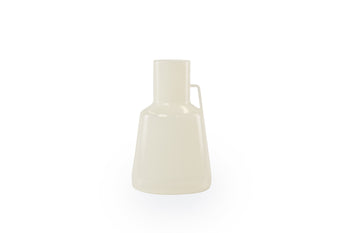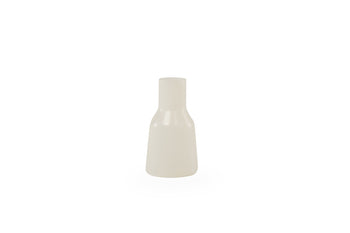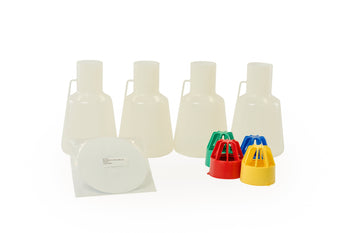Tunair Erlenmeyer Flasks - Polypropylene

Over time, standard glass Erlenmeyer flasks become etched, difficult to see through, and even harder to clean. Researchers who switch to polypropylene find years of worry-free use with flasks that won’t break down. But the advantages don’t end there. Read on to find the additional benefits you’d achieve by choosing IBI Scientific Tunair™ Shake Flasks: a unique and patented polypropylene flask and closure system.
Advantages of Tunair polypropylene Erlenmeyer flasks over glass flasks:
- Unique baffling and a patented turbo-vane closure create a high oxygen chamber with improved absorption rates resulting in enhanced cell yields
- Optimum growth conditions for aerobic microorganisms such as E. coli, mammalian cells, plant cells, and insect cells (sf9/BEVS), resulting in accelerated culture growth and productivity
- Culture growth up to 3x more for yeast & 2x for E. coli
- Completely autoclavable, including caps and filters
- Years of worry-free use
- Polypropylene will not break if dropped
- 5L Tunair Flasks come with a handle for easy transport
Better Gas Exchange = Better Growth
Small-scale cultivation of aerobic microorganisms is generally accomplished in test tubes or Erlenmeyer flasks. Aeration in these vessels is essentially by gas-liquid contact aided by shaking the vessels in a reciprocating or gyratory system. Methods used to increase surface area of the media inside the flask include internal baffles, wedge-shaped indentations, spikes, and angular-shaped flasks. These changes alone do not translate into higher aeration. The supply of air inside the vessel is also a limiting factor. The length of the neck of the flask or the type of closure can greatly affect the flow of air to the surface of the liquid.
Traditionally, the flasks or tubes are sealed with cotton plugs to prevent contamination. Cotton plugs offer considerable resistance to gas transfer, and consequently a low level of oxygen diffusion and poor escape of carbon dioxide result.
Other closures include loose-fitting stainless steel and plastic closures, gauze, foam, and silicon sponge plugs. Those closures allow improved oxygen exchange but have low working volumes and high shaker speeds.
The Tunair Advantage
Tunair™ Shake Flasks present an improved methodology for the growth of aerobic microorganisms and mammalian, insect, and plant cells. Tunair Flasks increase culture growth (up to 3 times for yeast) and increase productivity over traditional Erlenmeyer flasks.
The unique baffling and barrel-shape design increase the turbulence, with a corresponding increase in oxygen absorption. Tunair Flasks are a unique, high-aeration, reusable cell growth system. Tunair-designed systems increase availability of dissolved oxygen and improve cell yields.
| Three flask designs available: | Two filter options available: |
| No-baffle – normal throw | Silicone – lasts the life of the flask |
| Half-Baffle – 2 baffles create a vortex motion | Dri-Gauze – can be autoclaved up to 8 times |
| Full-Baffle – 6 baffles create a propeller motion |
All flasks have a wide mouth for easy inoculations, harvesting, and cleanup. The Tunair Erlenmeyer Flask cap closure has a larger surface area than cotton plugs, gauze, or foam pads, thus improving gas transfer. The wide-mouth cap can use either a 0.22 micron slip-on silicon or nitrocellulose membrane. Tunair Flasks have either 300 mL or 2.5 L high-capacity systems.
The Proof is in the Numbers
Tunair Erlenmeyer Flasks were compared to conventional flasks using four different types of microorganisms: Escherichia coli, Saccharomyces cerevisiae, Penicillium avellaneum, and Streptomyces chartreusis. The aeration capacities of the shake flasks were determined by the sulfate oxidation method, and values are presented as oxygen absorption rate (OAR) in mM oxygen/L/min. The growth rates of E. coli and S. cerevisiae were expressed as optical densities (OD) at 555 mM. For S. chartreusis and P. avellaneum, growth rates were evaluated by percent sedimentation. For E. coli and S. cerevisiae, the rates were determined after an 18-hour incubation period; for S. chartreusis, a 24-hour incubation period; and for P. avellaneum, a 72-hour incubation period. Growth and OAR evaluations were carried out with 3–9 replicates and statistically analyzed using Tukey’s w-procedure. The growth rates of the microorganisms in the different flasks are shown below:

With a unique baffling and turbo-vane closure design, Tunair™ Shake Flasks provide life science researchers with a system for improved cell density and greater yields. Order yours today or email us at info@ibisci.com with any questions.
















